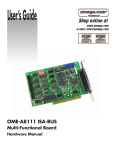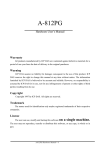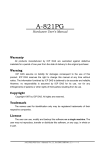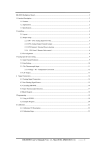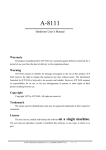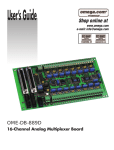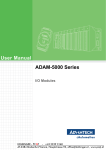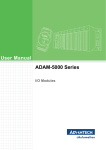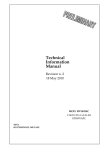Download Omega OME-A822PG User's Manual
Transcript
User’s Guide Shop online at www.omega.com e-mail: [email protected] OME-A822PG ISA-Bus Multi-Functional Board Hardware Manual OMEGAnet ® Online Service www.omega.com Internet e-mail [email protected] Servicing North America: USA: ISO 9001 Certified Canada: One Omega Drive, P.O. Box 4047 Stamford CT 06907-0047 TEL: (203) 359-1660 e-mail: [email protected] 976 Bergar Laval (Quebec) H7L 5A1, Canada TEL: (514) 856-6928 e-mail: [email protected] FAX: (203) 359-7700 FAX: (514) 856-6886 For immediate technical or application assistance: USA and Canada: Sales Service: 1-800-826-6342 / 1-800-TC-OMEGA® Customer Service: 1-800-622-2378 / 1-800-622-BEST® Engineering Service: 1-800-872-9436 / 1-800-USA-WHEN® TELEX: 996404 EASYLINK: 62968934 CABLE: OMEGA Mexico: En Espan˜ol: (001) 203-359-7803 FAX: (001) 203-359-7807 e-mail: [email protected] [email protected] Servicing Europe: Benelux: Postbus 8034, 1180 LA Amstelveen, The Netherlands TEL: +31 (0)20 3472121 FAX: +31 (0)20 6434643 Toll Free in Benelux: 0800 0993344 e-mail: [email protected] Czech Republic: Frystatska 184, 733 01 Karviná, Czech Republic TEL: +420 (0)59 6311899 FAX: +420 (0)59 6311114 Toll Free: 0800-1-66342 e-mail: [email protected] France: 11, rue Jacques Cartier, 78280 Guyancourt, France TEL: +33 (0)1 61 37 29 00 FAX: +33 (0)1 30 57 54 27 Toll Free in France: 0800 466 342 e-mail: [email protected] Germany/Austria: Daimlerstrasse 26, D-75392 Deckenpfronn, Germany TEL: +49 (0)7056 9398-0 Toll Free in Germany: 0800 639 7678 e-mail: [email protected] United Kingdom: ISO 9002 Certified FAX: +49 (0)7056 9398-29 One Omega Drive, River Bend Technology Centre Northbank, Irlam, Manchester M44 5BD United Kingdom TEL: +44 (0)161 777 6611 FAX: +44 (0)161 777 6622 Toll Free in United Kingdom: 0800-488-488 e-mail: [email protected] It is the policy of OMEGA to comply with all worldwide safety and EMC/EMI regulations that apply. OMEGA is constantly pursuing certification of its products to the European New Approach Directives. OMEGA will add the CE mark to every appropriate device upon certification. The information contained in this document is believed to be correct, but OMEGA Engineering, Inc. accepts no liability for any errors it contains, and reserves the right to alter specifications without notice. WARNING: These products are not designed for use in, and should not be used for, patient-connected applications. OME-A-822PGH/PGL Enhanced Multi-Function Card Hardware Manual OME-A-822PGL/PGH Hardware Manual ---- 1 Tables of Contents 1. Introduction_________________________________________________________ 4 1.1 General Description __________________________________________________ 4 1.2 Features _____________________________________________________________ 4 1.3 Specifications _________________________________________________________ 5 1.3.1 Power Consumption : ________________________________________________________ 5 1.3.2 Analog Inputs ______________________________________________________________ 5 1.3.3 A/D Converter _____________________________________________________________ 5 1.3.4 DA Converter ______________________________________________________________ 6 1.3.5 Digital I/O_________________________________________________________________ 6 1.3.6 Interrupt Channel ___________________________________________________________ 6 1.3.7 Programmable Timer/Counter _________________________________________________ 7 1.3.8 Direct Memory Access Channel (DMA) _________________________________________ 7 1.4 Applications __________________________________________________________ 8 1.5 Product Check List ____________________________________________________ 8 2. Hardware Configuration ______________________________________________ 9 2.1 Board Layout_________________________________________________________ 9 2.2 I/O Base Address Setting ______________________________________________ 10 2.3 Jumper Settings______________________________________________________ 11 2.3.1 JP1 : D/A Internal Reference Voltage Selection___________________________________ 11 2.3.2 JP2 : D/A Int/Ext Ref Voltage Selection ________________________________________ 12 2.3.3 JP3 : Single-ended/Differential Selection________________________________________ 12 2.3.4 JP4 : A/D Trigger Source Selection ____________________________________________ 13 2.3.5 JP5 : Interrupt Level Selection ________________________________________________ 13 2.3.6 JP6 : User Timer/Counter Clock Input Selection __________________________________ 14 2.3.7 JP7 : DMA DACK Selection, 2.4 JP8 : DMA DRQ Selection _____________________ 15 I/O Register Address__________________________________________________ 16 2.4.1 8254 Counter _____________________________________________________________ 17 2.4.2 A/D Input Buffer Register ___________________________________________________ 17 2.4.3 D/A Output Latch Register ___________________________________________________ 18 2.4.4 D/I Input Buffer Register ____________________________________________________ 19 2.4.5 Clear Interrupt Request______________________________________________________ 19 2.4.6 A/D Gain Control Register ___________________________________________________ 20 2.4.7 A/D Multiplex Control Register _______________________________________________ 21 2.4.8 A/D Mode Control Register __________________________________________________ 22 OME-A-822PGL/PGH Hardware Manual ---- 2 2.4.9 A/D Software Trigger Control Register _________________________________________ 23 2.4.10 D/O Output Latch Register __________________________________________________ 24 2.5 Digital I/O __________________________________________________________ 25 2.6 8254 Timer/Counter __________________________________________________ 26 2.7 A/D Conversion ______________________________________________________ 27 2.7.1 A/D conversion flow________________________________________________________ 28 2.7.2 A/D Conversion Trigger Modes _______________________________________________ 29 2.7.3 A/D Transfer Modes ________________________________________________________ 29 2.7.4 Using software trigger and polling transfer ______________________________________ 30 2.8 D/A Conversion ______________________________________________________ 31 2.9 Analog Input Signal Connection _________________________________________ 32 2.10 Using OME-DB-8225 CJC Output ______________________________________ 36 3. 4. Connector _________________________________________________________ 37 3.1 CN1/CN2/CN3 Pin Assignment _________________________________________ 37 3.2 Daughter Board________________________________________________________ 40 3.2.1 OME-DB-8225 ____________________________________________________________ 40 3.2.2 OME-DB-37 ______________________________________________________________ 40 3.2.3 OME-DB-16P _____________________________________________________________ 40 3.2.4 OME-DB-16R_____________________________________________________________ 40 Calibration___________________________________________________________ 41 4.1 Description of Variable Resistors ________________________________________ 41 4.2 D/A Calibration ______________________________________________________ 42 4.3 A/D Calibration ______________________________________________________ 43 5. Diagnostic Utility____________________________________________________ 44 5.1 Introduction_________________________________________________________ 44 5.2 Running The Diagnostic Utility _________________________________________ 46 5.2.1 Setup ____________________________________________________________________ 47 5.2.2 CALIBRATION ___________________________________________________________ 49 5.2.3 FUNCTION TEST _________________________________________________________ 50 5.2.4 SPECIAL TEST ___________________________________________________________ 58 5.2.5 Help ____________________________________________________________________ 59 OME-A-822PGL/PGH Hardware Manual ---- 3 1. Introduction 1.1 General Description The OME-A-822PGL/PGH is a high performance, multifunction analog, digital I/O board for PC AT compatible computers. The OME-A-822PGL provides low gain (0.5,1, 2, 4, 8). The OME-A-822PGH provides high gain (0.5,1,5,10,50,100,500,1000). The OME-A-822PGL/PGH contains a 12-bit ADC with up to 16 single-ended or 8 differential analog inputs. The maximum sample rate of the A/D converter is 100Ksample/sec. There are two 12-bit DACs with voltage output, 16 channels of TTL-compatible digital input, 16 channels of TTL-compatible digital output and one 16-bit counter/timer channel for timing input and output. The following A/D performance bench marks were achieved on a 33MHz 486 computer: z Polling mode : about 100Ksample/sec (with single-task OS) z z Interrupt mode DMA mode : about 60Ksample/sec (with single-task OS) : about 100Ksample/sec (with single-task OS) 1.2 Features z z z z z z z z z z z z The maximum sample rate of the A/D converter is 100 K samples/sec Software selectable input ranges PC AT compatible ISA bus A/D trigger mode : software trigger , pacer trigger, external trigger 16 single-ended or 8 differential analog input signals Programmable high gain : 0.5,1,5,10,50,100,500,1000 (OME-A-822PGH) Programmable low gain : 0.5,1,2,4,8 (OME-A-822PGL) 2 channel 12-bit D/A voltage output 16 digital input /16 digital output (TTL compatible) Interrupt handling Bipolar/Unipolar operation 1 channel general purpose programmable 16 bit timer/counter OME-A-822PGL/PGH Hardware Manual ---- 4 1.3 Specifications 1.3.1 z z Power Consumption : +5V @960 mA maximum, OME-A-822PGL/PGH Operating temperature : -20°C to 60°C 1.3.2 Analog Inputs z Channels : 16 single-ended or 8 differential z Input range : (software programmable) OME-A-822PGL:bipolar : ±10V,±5V, ±2.5V, ±1.25V, ±0.0625V unipolar : 0 to 10V, 0 to 5V, 0 to 0.2.5V, 0 to 1.25.V OME-A-822PGH:bipolar : ±10,±5V,±1V, ±0.5V, ±0.1V, ±0.05V, ±0.01V, ± 0.005V unipolar : 0 to 10V, 0 to 1V, 0 to 0.1V, 0 to 0.01V z Input current : 250 nA max (125 nA typical ) at 25 deg. C z On chip sample and hold Caution: refer to z Over voltage : continuous single channel to 70Vp-p z 1.3.3 z z z z Sec. 2.9 first Input impedance : 10 10 Ω // 6pF A/D Converter Type : successive approximation , Burr Brown ADS 774 or SIPEX-SP774B ( equivalent) Conversion time : 8 microsec. Accuracy : +/- 1 bit Resolution : 12 bits OME-A-822PGL/PGH Hardware Manual ---- 5 1.3.4 DA Converter z z z z Channels : 2 independent type : 12 bit multiplying , Analog device AD-7541 Linearity : +/- 1/2 bit Output range : 0 to 5V or 0 to 10V jumper selected , may be used with other AC or DC reference input. Maximum output limit +/- 10V z Output drive : +/- 5mA z settling time : 0.6 microseconds to 0.01% for full scale step 1.3.5 Digital I/O z Output port : 16 bits, TTL compatible Output Low: VOL=05.Vmax @IOL = 8 mA max Output High: VOH = 2.7Vmin @IOH = -400µA max z Input port : 16 bits, TTL compatible Input Low: VIL=0.8V max; IIL = -0.4mA max Input High: VIH=2.0V min; IIL = 20µA max 1.3.6 z z Interrupt Channel Level : 3,4,5,6,7,10,11,12,14,15, jumper selectable Enable : Via control register OME-A-822PGL/PGH Hardware Manual ---- 6 1.3.7 z z z z z z Type : 82C54 -8 programmable timer/counter Counters : Counter1 and counter2 are cascaded as a 32 bit pacer timer. Counter0 is a user available timer/counter. The software driver also uses counter0 to implement a machine independent timer. Clock input frequency : DC to 10 MHz Pacer output : 0.00047Hz to 0.5MHz Input ,gate : TTL compatible Internal Clock : 2 MHz 1.3.8 z z z z Programmable Timer/Counter Direct Memory Access Channel (DMA) Level : CH1 or CH3, jumper selectable Enable : via DMA bit of control register Termination : by interrupt on T/C Transfer rate : 100K conversions/sec. OME-A-822PGL/PGH Hardware Manual ---- 7 1.4 Applications z z z z z z z z Signal analysis FFT & frequency analysis Transient analysis Production testing Process control Vibration analysis Energy management Industrial and laboratory. measurement and control 1.5 Product Check List The OME-A-8322PGL/PGH includes the following items: z OME-A-822PGL/PGH multifunction card z OME-A-822PGL/PGH CD ROM Attention ! If any of these items are missing or damaged, please contact our customer service department. Save the shipping materials and carton in case you want to ship or store the product in the future. OME-A-822PGL/PGH Hardware Manual ---- 8 Hardware Configuration 2. 2.1 Board Layout JP4 OME-A-822PGL/PGH CN1 CN2 SW1 JP5 ISA BUS JP1 VR1/2/3/4/5/6/7 JP6 JP7 ISA BUS JP8 JP2 JP3 CN3 ---- 9 OME-A-822PGL/PGH Hardware Manual 2.2 I/O Base Address Setting The OME-A-822PGL/PGH occupies 16 consecutive locations in I/O address space. The base address is set by DIP switch SW1. The default address is 0x220. A9 A8 A7 A6 A5 A4 1 2 3 4 5 6 ON SW1 : BASE BASE ADDR ADDRESS A9 A8 A7 A6 A5 A4 200-20F OFF ON ON ON ON ON 210-21F OFF ON ON ON ON OFF 220-22F(;) OFF ON ON ON OFF ON 230-23F OFF ON ON ON OFF OFF : : : : : : : 300-30F OFF OFF ON ON ON ON : : : : : : : 3F0-3FF OFF OFF OFF OFF OFF (;) : default base address is 0x220 OME-A-822PGL/PGH Hardware Manual ---- 10 The PC I/O port map is given below. ADDRESS Device ADDRESS DEVICE 000-1FF PC reserved 320-32F XT Hard Disk 200-20F Game/control 378-37F Parallel Printer 210-21F XT Expansion Unit 380-38F SDLC 238-23F Bus Mouse/Alt. Bus Mouse 3A0-3AF SDLC 278-27F Parallel Printer 3B0-3BF MDA/Parallel Printer 2B0-2DF EGA 3C0-3CF EGA 2E0-2E7 AT GPIB 3D0-3DF CGA 2E8-2EF Serial Port 3E8-3EF Serial Port 2F8-2FF Serial Port 3F0-3F7 Floppy Disk 300-31F Prototype Card 3F8-3FF Serial Port 2.3 Jumper Settings 2.3.1 JP1 : D/A Internal Reference Voltage Selection Reference Voltage -5V (default) (-10V) 1 2 3 Reference Voltage -10V (-10V) 1 2 3 (-5V) (-5V) Select (-5V) : D/A voltage output = 0 to 5V (both channel) Select (-10V) : D/A voltage output = 0 to 10V (both channel) JP1 is valid only if JP2 is set to D/A internal reference voltage OME-A-822PGL/PGH Hardware Manual ---- 11 2.3.2 JP2 : D/A Int/Ext Ref Voltage Selection Ch 1 = INT Ch 2 = INT (default) JP2(vref) Ch 1 =EXT (ExtRef1) Ch 2 =EXT (ExtRef2) JP2(vref) Ch 1 = INT Ch 2 =EXT (ExtRef2) JP2(vref) Ch 1 =EXT (ExtRef1) Ch 2 = INT JP2(vref) If JP2 is set to internal reference, then JP1 should be set to -5V or -10V internal reference voltage. If JP2 is set to external reference, then ExtRef1, CN3 pin 31, is the external reference voltage for D/A channel 1. and ExtRef2, CN3 pin 12, is the external reference voltage for D/A Channel 2. 2.3.3 JP3 : Single-ended/Differential Selection Single-ended (default) SINGLE Differential DIFF SINGLE DIFF The OME-A-822PGL/PGH offers 16 single-ended or 8 differential analog input channels. The JP3 jumper sets the inputs to single-ended or differential mode. You can not select single-ended and differential simultaneously. Refer to Sec. 2.9 first. OME-A-822PGL/PGH Hardware Manual ---- 12 2.3.4 JP4 : A/D Trigger Source Selection INTTRG Internal Trigger (default) INTTRG External Trigger EXTTRG EXTTRG The OME-A-822PGL/PGH supports two trigger types, internal trigger and external trigger. The external trigger comes from ExtTrg, CN3 pin 17. There are two types of internal triggers, software trigger and pacer trigger. More detailed information is given in section 2.4.8. 2.3.5 JP5 : Interrupt Level Selection NO Interrupt IRQ 3 4 5 6 7 9 10 11 12 14 15 NC IRQ 3 4 5 6 7 9 10 11 12 14 15 NC Interrupt 15 (default) The interrupt channel can not be shared. The OME-A-822 software driver can support 8 different cards in one system but only 2 of these cards can use the interrupt transfer function. OME-A-822PGL/PGH Hardware Manual ---- 13 2.3.6 JP6 : User Timer/Counter Clock Input Selection Internal 2M Clock (default) INTCLK External Clock EXTCLK INTCLK EXTCLK The OME-A-822PGL/PGH has 3 independent 16 bit timer/counters. The cascaded counter1 and counter2 are used as a pacer timer. Counter0 can be used as a user programmable timer/counter. The user programmable timer/counter can be set to 2M internal clock or external clock ExtCLK, CN3 pin 37. The block diagram is given in section 2.6. The clock source must be very stable. Using the 2M internal clock is strongly suggested. The OME-A-822PGL/PGH software driver uses counter0 as a machine independent timer. If users program calls the A-822_Delay() subroutine, counter0 will be programmed as a machine independent timer. More detailed information is provided in section 2.6. NOTE : if you use A-822_Delay(), the JP6 jumper must be set to internal 2M clock. OME-A-822PGL/PGH Hardware Manual ---- 14 2.3.7 JP7 : DMA DACK Selection, JP8 : DMA DRQ Selection DRQ NO DMA DMA 1 (default) DACK 1 2 1 2 5 6 5 6 JP7 JP8 DRQ DACK 1 2 1 2 5 6 5 6 DMA 3 JP7 JP8 DRQ DACK 1 2 1 2 5 6 5 6 JP7 JP8 The DMA channel can not shared. The OME-A-822 software driver can support 8 different boards in one PC based system, but only two of these boards can use the DMA transfer function. OME-A-822PGL/PGH Hardware Manual ---- 15 2.4 I/O Register Address The OME-A-822PGL/PGH occupies 16 consecutive PC I/O addresses. The following table lists the registers and their locations. Address Read Write Base+0 8254 Counter 0 8254 Counter 0 Base+1 8254 Counter 1 8254 Counter 1 Base+2 8254 Counter 2 8254 Counter 2 Base+3 Reserved 8254 Counter Control Base+4 A/D Low Byte D/A Channel 0 Low Byte Base+5 A/D High Byte D/A Channel 0 High Byte Base+6 DI Low Byte D/A Channel 1 Low Byte Base+7 DI High Byte D/A Channel 1 High Byte Base+8 Reserved A/D Clear Interrupt Request Base+9 Reserved A/D Gain Control Base+A Reserved A/D Multiplexer Control Base+B Reserved A/D Mode Control Base+C Reserved A/D Software Trigger Control Base+D Reserved DO Low Byte Base+E Reserved DO High Byte Base+F Reserved Reserved OME-A-822PGL/PGH Hardware Manual ---- 16 2.4.1 8254 Counter The 8254 Programmable timer/counter has 4 registers from Base+0 through Base+3. For detailed programming information on the 8254 , please refer to Intel‘s “Microsystem Components Handbook”. Address Read Write Base+0 8254 Counter 0 8254 Counter 0 Base+1 8254 Counter 1 8254 Counter 1 Base+2 8254 Counter 2 8254 Counter 2 Base+3 Reserved 8254 Counter Control 2.4.2 A/D Input Buffer Register (READ) Base+4 : A/D Low Byte Data Format Bit 7 Bit 6 Bit 5 Bit 4 Bit 3 Bit 2 Bit 1 Bit 0 D7 D6 D5 D4 D3 D2 D1 D0 (READ) Base+5 : A/D High Byte Data Format Bit 7 Bit 6 Bit 5 Bit 4 Bit 3 Bit 2 Bit 1 Bit 0 0 0 0 READY D11 D10 D9 D8 A/D 12 bit data : D11…..D0, D11=MSB, D0=LSB READY =1 : A/D 12 bit data not ready =0 : A/D 12 bit data is ready The low 8 bit A/D data is stored in address BASE+4 and the high 4 bit data is stored in address BASE+5. The READY bit is used as an indicator for the A/D conversion. When an A/D conversion is completed, the READY bit will clear to zero. OME-A-822PGL/PGH Hardware Manual ---- 17 2.4.3 D/A Output Latch Register (WRITE) Base+4 : Channel 1 D/A Low Byte Data Format Bit 7 Bit 6 Bit 5 Bit 4 Bit 3 Bit 2 Bit 1 Bit 0 D7 D6 D5 D4 D3 D2 D1 D0 (WRITE) Base+5 :Channel 1 D/A High Byte Data Format Bit 7 Bit 6 Bit 5 Bit 4 Bit 3 Bit 2 Bit 1 Bit 0 X X X X D11 D10 D9 D8 (WRITE) Base+6 : Channel 2 D/A Low Byte Data Format Bit 7 Bit 6 Bit 5 Bit 4 Bit 3 Bit 2 Bit 1 Bit 0 D7 D6 D5 D4 D3 D2 D1 D0 (WRITE) Base+7 :Channel 2 D/A High Byte Data Format Bit 7 Bit 6 Bit 5 Bit 4 Bit 3 Bit 2 Bit 1 Bit 0 X X X X D11 D10 D9 D8 D/A 12 bit output data: D11..D0, D11=MSB, D0=LSB, X=don‘t care The D/A converter will convert the 12 bit digital data to an analog output. The lower 8 bits of D/A channel 1 are stored in the address BASE+4 and the high 4 bits are stored in the address BASE+5. The address BASE+6 and BASE+7 store the 12 bit data for D/A channel 2. The D/A output latch registers are designed with a “double buffered” structure, so the analog output latch registers will not update until the high 4 bit digital data are written. If the user sends the high 4 bit data first, the D/A 12 bit output latch registers will update at once. So the lower 8 bits will be the previous data latched in the register. This action will cause an error on the D/A output voltage. The user must send the low 8 bits first and then send the high 4 bits to update the 12 bit D/A output latch register. NOTE : Send the low 8 bits first, then send the high 4 bits. OME-A-822PGL/PGH Hardware Manual ---- 18 2.4.4 D/I Input Buffer Register (READ) Base+6 : D/I Input Buffer Low Byte Data Format Bit 7 Bit 6 Bit 5 Bit 4 Bit 3 Bit 2 Bit 1 Bit 0 D7 D6 D5 D4 D3 D2 D1 D0 (READ) Base+7 : D/I Input Buffer High Byte Data Format Bit 7 Bit 6 Bit 5 Bit 4 Bit 3 Bit 2 Bit 1 Bit 0 D15 D14 D13 D12 D11 D10 D9 D8 D/I 16 bits input data : D15..D0, D15=MSB, D0=LSB The OME-A-822PGL/PGH provides 16 TTL compatible digital inputs. The low 8 bits are stored in the address BASE+6. The high 8 bits are stored in address BASE+7. 2.4.5 Clear Interrupt Request (WRITE) Base+8 : Clear Interrupt Request Format Bit 7 Bit 6 Bit 5 Bit 4 Bit 3 Bit 2 Bit 1 Bit 0 X X X X X X X X X=don‘t care, XXXXXXXX=any 8 bits data is validate If the OME-A-822PGL/PGH is used in the interrupt transfer mode, an on-board hardware status bit will be set after each A/D conversion. This bit must be cleared by software before the next hardware interrupt. Writing any value to address BASE+8 will clear this hardware bit and the hardware will generate another interrupt when next A/D conversion is completed. OME-A-822PGL/PGH Hardware Manual ---- 19 2.4.6 A/D Gain Control Register (WRITE) Base+9 : A/D Gain Control Register Format Bit 7 Bit 6 Bit 5 Bit 4 Bit 3 Bit 2 Bit 1 Bit 0 X X X X GAIN3 GAIN2 GAIN1 GAIN0 The only difference between the OME-A-822PGL and OME-A-822PGH is the GAIN control function. The OME-A-822PGL provides gains of 1/2/4/8 and the OME-A-822PGH provides gains of 1/10/100/1000. The gain control register control the gain of the A/D input signal. Bipolar/Unipolar will affect the gain factor. It is important to select the correct gain-control-code according to Bipolar/Unipolar input. NOTE : If the gain control code is changed, the hardware needs an extra delay for the gain settling time. The gain settling time is different for the different gain control codes. The software driver does not take care the gain settling time, so the user needs to add the delay . If the application program will run on different machines, the user needs to implement a machine independent timer. The software driver, A-822_delay(), is designed for this purpose. If this subroutine is used, then counter2 as described in sec 2.6 is reserved by the software driver to implement the machine independent timer. OME-A-822PGL GAIN CONTROL CODE TABLE BI/UNI Settling Time GAIN Input Range GAIN3 GAIN2 GAIN1 GAIN0 BI 23 us 1 +/- 5V 0 0 0 0 BI 23 us 2 +/- 2.5V 0 0 0 1 BI 25 us 4 +/- 1.25V 0 0 1 0 BI 28 us 8 +/- 0.0625V 0 0 1 1 UNI 23 us 1 0V to 10V 0 1 0 0 UNI 23 us 2 0V to 5V 0 1 0 1 UNI 25 us 4 0V to 2.5V 0 1 1 0 UNI 28 us 8 0V to 1.25V 0 1 1 1 BI 23 us 0.5 +/- 10V 1 0 0 0 BI=Bipolar, UNI=Unipolar, X=don‘t care, N/A=not available OME-A-822PGL/PGH Hardware Manual ---- 20 OME-A-822PGH GAIN CONTROL CODE TABLE BI/UN Settling Time GAIN Input Range GAIN3 GAIN2 GAIN1 GAIN0 BI 23 us 1 +/- 5V 0 0 0 0 BI 28 us 10 +/- 0.5V 0 0 0 1 BI 140 us 100 +/- 0.05V 0 0 1 0 BI 1300 us 1000 +/- 0.005V 0 0 1 1 UNI 23 us 1 0 to 10V 0 1 0 0 UNI 28 us 10 0 to 1V 0 1 0 1 UNI 140 us 100 0 to 0.1V 0 1 1 0 UNI 1300 us 1000 0 to 0.01V 0 1 1 1 BI 23 us 0.5 +/- 10V 1 0 0 0 BI 28 us 5 +/- 1V 1 0 0 1 BI 140 us 50 +/- 0.1V 1 0 1 0 BI 1300 us 500 +/- 0.01V 1 0 1 1 BI=Bipolar, UNI=Unipolar, X=don‘t care, N/A=not available 2.4.7 A/D Multiplex Control Register (WRITE) Base+A : A/D Multilexer Control Register Format Bit 7 Bit 6 Bit 5 Bit 4 Bit 3 Bit 2 Bit 1 Bit 0 X X X X D3 D2 D1 D0 A/D input channel selection data = 4 bits : D3..D0, D3=MSB, D0=LSB, X=don‘t care Single-ended mode : D3..D0 Differential mode : D2..D0, D3=don’t care The OME-A-822PGL/PGH provides 16 single-ended or 8 differential analog input signals. In single-ended mode, D3..D0 selects the active channel. In differential mode, D2..D0 selects the active channel and (D3 has no affect). NOTE: The settling time of the multiplexer depends on the resistance.of the input sources. source resistance = about 0.1K ohm Æ settling time = about 3 us. source resistance = about 1K ohm Æ settling time = about 5 us. source resistance = about 10K ohm Æ settling time = about 10 us. source resistance = about 100K ohm Æ settling time = about 100 us. OME-A-822PGL/PGH Hardware Manual ---- 21 2.4.8 A/D Mode Control Register (WRITE) Base+B : A/D Mode Control Register Format Bit 7 Bit 6 Bit 5 Bit 4 Bit 3 Bit 2 Bit 1 Bit 0 X X X X X D2 D1 D0 X=don‘t care JP4 Select Internal Trigger Mode Select Trigger Type Transfer Type D2 D1 D0 Software Trig Pacer Trig Software Interrupt DMA 0 0 0 X X X X X 0 0 1 Select X Select X X 0 1 0 X Select X X Select 1 1 0 X Select Select Select X X=disable JP4 Select External Trigger Mode Select Trigger Type Transfer Type D2 D1 D0 External Trigger Software Interrupt DMA 0 0 0 X X X X 0 0 1 X X X X 0 1 0 Select X X Select 1 1 0 Select Select Select X The A/D conversion can be divided into 2 stages, trigger stage and transfer stage. The trigger stage will generate a trigger signal to the A/D converter and the transfer stage will transfer the result to the CPU. The trigger method may be internal trigger or external trigger. The internal trigger can be software trigger or pacer trigger. The software trigger is simple to use but does not control the sampling rate very precisely. In the software trigger mode, the program issues a software trigger command (sec 2.4.9) to initiate the A/D conversion. The program then must poll the A/D status bit until the ready bit is 0(sec 2.4.2). The pacer trigger can control the sample rate very precisely. In the pacer trigger mode, the pacer timer (sec 2.6) will generate periodic trigger signals to the A/D converter. The converted data can be transferred to the CPU by polling or interrupt or by DMA transfer. OME-A-822PGL/PGH Hardware Manual ---- 22 The software driver provides three data transfer methods, polling, interrupt and DMA. The polling subroutine, A-822_AD_PollingVar() or A-822_AD_PollingArray(), set the A/D mode control register to 0x01. This control word enables software trigger and polling transfer. The interrupt subroutine, A-822_AD_INT_START(…), sets the A/D mode control mode register to ox06. This control word enables pacer trigger and interrupt transfer. The DMA subroutine, A-822_AD_DMA_START(…), sets the A/D mode control register to 0x02. This control word means pacer trigger and DMA transfer. Please refer to sec. 2.7 for detailed information. 2.4.9 A/D Software Trigger Control Register (WRITE) Base+C : A/D Software Trigger Control Register Bit 7 Bit 6 Bit 5 Bit 4 Bit 3 Bit 2 Bit 1 Bit 0 X X X X X X X X X=don‘t care, XXXXXXXX=any 8 bits data is validate The A/D converter can be triggered by software trigger or pacer trigger. The details are given in sec. 2.4.8 and sec. 2.7. Writing any value to address BASE+C will generate a trigger pulse to the A/D converter and initiate an A/D conversion. The address BASE+5 offers a ready bit to indicate an A/D conversion is completed. The software driver uses this control word to detect the OME-A-822PGL/PGH hardware board. The software initiates a software trigger and checks the ready bit . If the ready bit can not cleared to zero in a fixed time, the software driver will return a error message. If there is an I/O BASE address error, the ready bit will not be cleared to zero. The software driver, A-822_CheckAddress(), uses this method to detect the I/O BASE address setting OME-A-822PGL/PGH Hardware Manual ---- 23 2.4.10 D/O Output Latch Register (WRITE) Base+D : D/O Output Latch Low Byte Data Format Bit 7 Bit 6 Bit 5 Bit 4 Bit 3 Bit 2 Bit 1 Bit 0 D7 D6 D5 D4 D3 D2 D1 D0 (WRITE) Base+E : D/O Output Latch High Byte Data Format Bit 7 Bit 6 Bit 5 Bit 4 Bit 3 Bit 2 Bit 1 Bit 0 D15 D14 D13 D12 D11 D10 D9 D8 D/O 16 bits output data : D15..D0, D15=MSB, D0=LSB The OME-A-822PGL/PGH provides 16 TTL compatible digital outputs. The lower 8 bits are stored in address BASE+D. The high 8 bits are stored in address BASE+E OME-A-822PGL/PGH Hardware Manual ---- 24 2.5 Digital I/O The OME-A-822PGL/PGH provides 16 digital input channels and 16 digital output channels. All levels are TTL compatible. The connection diagram and block diagram are given below: Output Latch Register Base+D Latch D0..D7 D0..D7 Power on reset Reset CN2 Reset DI DGND 17..18 DGND 9..16 D8..D15 Base+E TTL 1..8 Latch External Device Output Latch Register OME-A-822PGL/PGH Input Buffer Register Base+6 Read D0..D7 D0..D7 D8..D15 Base+7 Read OME-A-822PGL/PGH CN1 TTL 1..8 17..18 DGND DO DGND 9..16 Input Buffer Register External Device OME-A-822PGL/PGH Hardware Manual ---- 25 2.6 8254 Timer/Counter The 8254 Programmable timer/counter has 4 registers from Base+0 through Base+3. For detailed programming information about the 8254 , please refer to Intel‘s “Microsystem Components Handbook”.The block diagram is shown below. VCC 10K CN3.33 CN3.16 Gate JP6 CN3.37 Cin 2M Cout Counter 0 PACER CLK CN3.35 Cin : clock input Cout : clock output INTCLK : internal clock CN3 : connector CN3 VCC Counter 1 Cin Gate Cout 10K Counter 2 4M 2M INTCLK Cin Gate Cout CN3.34 The counter0, counter1 and counter2 are all 16 bit counters. Counter 1 and counter 2 are cascaded as a 32 bit timer. This 32 bit timer is used as a pacer timer. The software driver, A-822_Delay(), uses counter 0 to implement a machine independent timer for settling time delay (sec. 2.4.6 and sec. 2.4.7). If A-822_Delay() is not used, counter0 can be used as a general purpose timer/counter. NOTE : When using A-822_Delay() to implement a machine independent timer, the JP6 jumper must be set to internal 2M clock. OME-A-822PGL/PGH Hardware Manual ---- 26 2.7 A/D Conversion This section explains how to perform A/D conversions. The A/D conversion can be triggered 3 ways, by software trigger, by pacer trigger or by external trigger to the A/D converter. At the end of A/D conversion, it is possible to transfer data by 3 ways, those are polling , interrupt and DMA. Before using the A/D conversion functions, the user should be aware of the following issues: z z z A/D data register BASE+4/BASE+5 stores the A/D conversion data (sec. 2.4.2) A/D gain control register BASE+9 selects the gain (sec. 2.4.6) A/D multiplexer control register BASE+A selects the analog input channel (sec. 2.4.7) z A/D mode control register BASE+B selects the trigger type and transfer type (sec. 2.4.8) A/D software trigger control register is BASE+C (sec. 2.4.9) JP3 selects single-ended or differential input (sec. 2.3.3) JP4 selects internal/external trigger (sec. 2.3.4) JP5 selects the IRQ level (sec. 2.3.5) JP6 selects the internal/external clock for counter0 (sec. 2.3.6) JP7 and JP8 selects the DMA channel (sec. 2.3.7) z z z z z z z z There are 3 trigger types : software, pacer, external trigger (sec. 2.4.8) There are 3 transfer types : polling, interrupt, DMA (sec. 2.4.8) The block diagram is given below: CN3 16/8 to 1 Multiplexer Gain control 12 bits A/D Buffer Memory Base+A Base+9 Trigger Logic Transfer Logic CPU JP3 Base+C JP4 Base+B JP5 JP7 JP8 OME-A-822PGL/PGH Hardware Manual ---- 27 OME-A-822PGL/PGH 2.7.1 A/D conversion flow Before using the A/D converter, the user should configure the following hardware settings: 1. select single-ended or differential input (JP3) (refer to Sec. 2.9 first) 2. select internal trigger or external trigger (JP4) 3. select IRQ level if needed (JP5) 4. select DMA channel if needed (JP7,JP8) 5. select internal clock or external clock for counter0 if needed (JP6) The user must decide which A/D conversion mode will be used. The software driver supports three different modes: polling, interrupt and DMA. The polling mode (sec. 2.4.9) is the simplest but most limited. The software driver should be used for interrupt or DMA mode. The analog input signals come from CN3. These signals may be single-ended or differential and must match the setting of JP3. The multiplexer can select 16 single-ended or 8 differential signals into the gain control module. The settling time of multiplexer depends on the source resistance. Because the software doesn’t account for the settling time, the user should provide sufficient delay when switching channels. (sec. 2.4.7) The gain control module also requires settling time if the gain control code is changed. Since the software doesn’t account for settling time, the user should provide sufficient delay if the gain control code is changed. (sec. 2.4.6) The software driver provides a machine independent timer, A-822_Delay(), for settling time delay. This subroutine assumes that the JP6 jumper is set to the internal 2M clock and uses counter0 to implement a machine independent timer. If A-822_Delay() is used, counter0 will be reserved and can not be used as a user programmable timer/counter. The A/D converter needs a trigger signal to start an A/D conversion cycle. The OME-A-822PGL/PGH supports three trigger modes, software, pacer and external trigger. The result of the A/D conversion can be transferred into the PC memory by three modes: polling, interrupt and DMA.. OME-A-822PGL/PGH Hardware Manual ---- 28 2.7.2 A/D Conversion Trigger Modes OME-A-822PGL/PGH supports three trigger modes. 1 : Software Trigger : Write any value to the A/D software trigger control register, BASE+A, to initiate an A/D conversion cycle. This mode is very simple but it is very difficult to achieve a precise sample rate. 2 : Pacer Trigger Mode : The block diagram of the pacer timer is shown in section 2.6. The pacer timer can provide a very precise sample rate. 3 : External Trigger Mode : When a rising edge of an external trigger signal is applied, an A/D conversion will be performed. The external trigger source comes from pin 17 of CN3. 2.7.3 A/D Transfer Modes OME-A-822PGL/PGH supports three transfer modes. 1 : polling transfer : This mode can be used with all trigger modes. More detailed information is given in section 2.4.8. The software scans the A/D high byte data register, BASE+5, until READY_BIT=0.The low byte data is available in BASE+4. 2 : interrupt transfer : This mode can be used with the pacer trigger or external trigger. More detailed information is given in section 2.4.8.The user can set the IRQ level by adjusting jumper JP5. A hardware interrupt signal is sent to the PC when an A/D conversion is 3 : completed. DMA transfer : This mode can be used with the pacer trigger or external trigger. More detailed information is given in section 2.4.8. The user can set the DMA channel by adjusting jumpers JP7 and JP8. Two hardware DMA requests signals are sent sequentially to the PC when an A/D conversion is completed. The single mode transfer of the 8237 is suggested. OME-A-822PGL/PGH Hardware Manual ---- 29 2.7.4 Using software trigger and polling transfer If the user needs to control the A/D converter without the A-822 software driver, software trigger and polling transfer is suggested. The program steps are listed below: 1. send 0x01 to the A/D mode control register (software trigger + polling transfer) (refer to Sec. 2.4.8) 2. send channel number to the multiplexer control register (refer to Sec. 2.4.7) 3. send the gain control code value to the gain control register (refer to Sec 2.4.6) 4. delay the settling time (refer to Sec. 2.4.6 and Sec. 2.4.7) 5. send any value to the software trigger control register to generate a software trigger signal (refer to Sec. 2.4.9) 6. scan the READY bit of the A/D high byte data until READY=0 (refer to Sec. 2.4.2) 7. read the 12 bit A/D data (refer to Sec. 2.4.2) 8. convert the 12 bit binary data to a floating point value OME-A-822PGL/PGH Hardware Manual ---- 30 2.8 D/A Conversion The OME-A-822PGL/PGH provides two 12 bit D/A converters. Before using the D/A converter function, you should address the following items: z z z z z z D/A output register, BASE+4/BASE+5/BASE+6/BASE+7, (sec. 2.4.3) JP1 jumper set to internal reference voltage -5V or -10V (sec. 2.3.1) JP2 jumper set to internal or external reference voltage (sec. 2.3.2) If JP2 is set to internal and JP1 is set to -5V, the D/A output range is 0 to 5V If JP2 is set to internal and JP1 is set to -10V, the D/A output range is 0 to 10V If JP2 is set to external, the external reference voltage can be AC/DC +/- 10V The block diagram is given below: CN3 D/A channel 0 Base+4/+5 D0..D7 Ref -5/-10 V Internal Reference Ref Base+6/+7 OME-A-822PGL/PGH V0- 9,10,14,28,29 Analog Gnd JP1 JP2 V0+ 30 D/A channel 1 31 Vref0+ Vref0- Vref1+ Vref1- 12 32 V1+ NOTE : The D/A output latch registers use a “double buffer” structure. The V1- user must send the low byte data first, then send the high byte data. If the user only sends the high byte, the low byte data will be the previous value. OME-A-822PGL/PGH Hardware Manual ---- 31 2.9 Analog Input Signal Connection The OME-A-822 can measure signals in the single-ended or differential mode. In the differential mode each channel has a unique signal HIGH and signal LOW connection. In the single-ended mode all channels have a unique signal HIGH connection but share a common LOW or ground connection. Differential connections are very useful for low level signals (millivolt), since they better reject electrical noise that can affect the quality of the measurement. A differential connection is also necessary when a common ground is unacceptable. The benefit of using a single-ended connection is that twice the number of channels is available. In general, a single-ended connection is often a good choice when working with higher level signals (5V or 10V for example), especially if the signal is coming from an isolated device such as a signal conditioner. Several different types of wiring diagrams are discussed below. Figure 1-A shows a differential connection to a grounded source. If the source is grounded, making a second connection to the card’s ground could cause a ground loop resulting in erroneous data. It is important to note that the maximum common mode voltage between the input source and AGND is 70Vp-p. If the card is connected to a source with a common mode voltage greater than 70Vp-p, the input multiplexer will be permanently damaged! When measuring common mode voltage, it is best to use an oscilloscope rather than a multi-meter. Figure 1-B shows a differential connection to a floating source. In such cases a connection should be made between the low channel input and analog ground. Figure 2 shows connection of multiple sources in single-ended mode. This connection assumes creating one common ground will not cause a problem. This is normally the case when connecting to devices that are isolated or floating. Figure 3 demonstrates how to connect bridge transducers. Bridge transducers include strain gauges, load cells and certain type of pressure transducers. The diagram assumes that there is a single external power supply providing power to the bridge. Each bridge is connected to a differential channel. No connection is made between channel low and analog ground. A connection should be made between analog ground and the negative of the power supply. An isolated power supply is strongly suggested. Figure 4 demonstrates how to connect a 4-20mA current loop. Since the card reads voltages, the current is converted to voltage by passing it through a shunt resistor. By Ohms law (V=IR), when using a 250Ω resistor, 4 mA will be converted to 1V and 20mA to 5V. If the source is linear, the output voltage range will also be linear. OME-A-822PGL/PGH Hardware Manual ---- 32 Figure 1-A If the source is grounded, a second ground connection on the card could result in a ground loop. Figure 1-B OME-A-822PGL/PGH Hardware Manual ---- 33 Figure 2 Figure 3 OME-A-822PGL/PGH Hardware Manual ---- 34 Figure 4 R is a shunt resistor. A 250Ω shunt resistor converts 4-20mA to 1-5Vdc. Signal Shielding z z The signal shielding is the same for the connections shown in Figure 1 to Figure 4 Use a single connection to frame ground (not A.GND or D.GND) Vin OME-A-822PGL/PGH A.GND D.GND Frame Ground OME-A-822PGL/PGH Hardware Manual ---- 35 2.10 Using OME-DB-8225 CJC Output The OME-DB-8225 daughter board contains built-in cold junction compensation (CJC) circuitry that provides a 10mV per Deg C output. With 0.0 Volts @ -273 Deg C. The OME-A-822 should be protected from drafts and direct sunlight in order to accurately reflect room temperature. CJC Calibration: 1. Connect the OME-A-822PGL/PGH to the OME-DB-8225 CN1 2. Set the OME-A-822PGL/PGH to single-ended Mode 3. Set the JP1 jumper to 1-2 and the JP2 jumper to 2-3 ( single-ended mode) 4.Read the temperature from a digital thermometer placed near D1/D2(See the OME-DB-8225 Layout) . 5.Read OME-A-822PGL/PGH analog input channel 0 (single-ended Channel 0) 6.Adjust VR1 until a stable reading of 10mV per deg C is attained . For example, when the ambient temperature is 24 deg C. the reading value of CJC will be 2.97V (273 deg c +24 deg c ) X 10 mV/deg c = 2.97V You will need an A/D channel for the CJC calibration. AI0 is reserved for CJC calibration when used in single-ended mode and CH0-HI & CH0-LO is reserved for the differential mode. differential mode is recommended when working with thermocouples. OME-A-822PGL/PGH Hardware Manual ---- 36 3. Connector The OME-A-822PGL/PGH provides three connectors. Connector 1, CN1 contains the 16 digital inputs. Connector 2, CN2, contains the 16 digital outputs. Connector 3, CN3, contains the analog inputs, analog outputs and timer/counter I/O. 3.1 CN1/CN2/CN3 Pin Assignment CN1 : Digital Input Pin Assignment. Pin Number Description Pin Number Description 1 Digital Input 0/TTL 2 Digital Input 1/TTL 3 Digital Input 2/TTL 4 Digital Input 3/TTL 5 Digital Input 4/TTL 6 Digital Input 5/TTL 7 Digital Input 6/TTL 8 Digital Input 7/TTL 9 Digital Input 8/TTL 10 Digital Input 9/TTL 11 Digital Input 10/TTL 12 Digital Input 11/TTL 13 Digital Input 12/TTL 14 Digital Input 13/TTL 15 Digital Input 14/TTL 16 Digital Input 15/TTL 17 GND 18 GND 19 +5V Output 20 +12V Output CN2 : Digital Output Pin Assignment. Pin Number Description Pin Number Description 1 Digital Output 0/TTL 2 Digital Output 1/TTL 3 Digital Output 2/TTL 4 Digital Output 3/TTL 5 Digital Output 4/TTL 6 Digital Output 5/TTL 7 Digital Output 6/TTL 8 Digital Output 7/TTL 9 Digital Output 8/TTL 10 Digital Output 9/TTL 11 Digital Output 10/TTL 12 Digital Output 11/TTL 13 Digital Output 12/TTL 14 Digital Output 13TTL 15 Digital Output 14/TTL 16 Digital Output 15/TTL 17 GND 18 GND 19 +5V Output 20 +12 OutputV OME-A-822PGL/PGH Hardware Manual ---- 37 SINGLE-ENDED SIGNAL MODE CN3 : Analog input, Analog output and Timer/Counter Pin Assignment. Pin Number Description Pin Number Description 1 Analog Input 0/+ 20 Analog Input 8/+ 2 Analog Input 1/+ 21 Analog Input 9/+ 3 Analog Input 2/+ 22 Analog Input 10/+ 4 Analog Input 3/+ 23 Analog Input 11/+ 5 Analog Input 4/+ 24 Analog Input 12/+ 6 Analog Input 5/+ 25 Analog Input 13/+ 7 Analog Input 6/+ 26 Analog Input 14/+ 8 Analog Input 7/+ 27 Analog Input 15/+ 9 Analog GND 28 Analog GND 10 Analog GND 29 Analog GND 11 D/A internal -5V/-10V voltage reference 30 D/A channel 0 analog voltage output 12 D/A channel 1 external voltage reference input 31 D/A channel 0 external voltage reference input 13 +12V Output 32 D/A channel 1 analog voltage output 14 PCB 33 User timer/counter‘s GATE control input 15 PCB digital GND 34 Timer/counter 1&2 control input 16 User timer/counter output 35 Timer/counter 1 output 17 External trigger source input/TTL 36 Reserved 18 Reserved 37 User timer/counter external clock input (internal=2M) 19 analog GND +5V Output XXXXXXX This pin not available OME-A-822PGL/PGH Hardware Manual ---- 38 GATE DIFFERENTIAL SIGNALS CN3 : Analog input, Analog output and Timer/Counter Pin Assignment. Pin Number Description Pin Number Description 1 Analog Input 0/+ 20 Analog Input 0/- 2 Analog Input 1/+ 21 Analog Input 1/- 3 Analog Input 2/+ 22 Analog Input 2/- 4 Analog Input 3/+ 23 Analog Input 3/- 5 Analog Input 4/+ 24 Analog Input 4/- 6 Analog Input 5/+ 25 Analog Input 5/- 7 Analog Input 6/+ 26 Analog Input 6/- 8 Analog Input 7/+ 27 Analog Input 7/- 9 Analog GND 28 Analog GND 10 Analog GND 29 Analog GND 11 D/A internal -5V/-10V voltage reference output 30 D/A channel 0 analog voltage output 12 D/A channel 1 external voltage reference input 31 D/A channel 0 external voltage reference input 13 +12V Output 32 D/A channel 1 analog voltage output 14 Analog GND 33 User timer/counter GATE control input 15 Digital GND output 34 Timer/counter 1&2 GATE control input 16 User timer/counter output 35 Timer/counter 1 output 17 External trigger source input/TTL 36 Reserved 18 Reserved 37 User timer/counter external clock input (internal=2M) 19 +5V output XXXXXXX This pin not available OME-A-822PGL/PGH Hardware Manual ---- 39 3.2 Daughter Board The OME-A-822PGL/PGH can be connected with many different daughter boards. The daughter boards are described below: 3.2.1 OME-DB-8225 The OME-DB-8225 provides an on-board CJC(Cold Junction Compensation) circuit for thermocouple measurement and a terminal block for easy signal connection. The CJC is connected to A/D channel_0. The OME-A-822PGL/PGH can connect to an OME-DB-8225 through a 37-pin D-sub connector on CN3. 3.2.2 OME-DB-37 The OME-DB-37 is a general purpose 37-pin screw terminal board. It connects to a 37-pin D-sub connector. 3.2.3 OME-DB-16P The OME-DB-16P is a 16 channel isolated digital input board. The OME-A-822PGL/PGH provides 16 channels of non-isolated TTL-compatible digital inputs via the CN1 connector. If used with the OME-DB-16P, the OME-A-822PGL/PGH can provide 16 channels of isolated digital input. Isolation can protect the computer if abnormal or excessive input signals are received. 3.2.4 OME-DB-16R The OME-DB-16R provides 16 SPDT relay outputs. The OME-A-822PGL/PGH provides 16 TTL-compatible digital outputs via CN2. If connecting to the OME-DB-16R, the OME-A-822PGL/PGH can provide 16 relay outputs to control external devices. OME-A-822PGL/PGH Hardware Manual ---- 40 4. Calibration The OME-A-822PGL/PGH is factory calibrated for optimum performance. Recalibration is suggested for high vibration environments. The following items are required for calibrating the OME-A-822PGL/PGH. z z z One 6 digit multimeter One stable voltage source (4.9988V) Diagnostic program : this program included with the OME-A822PGL/PGH. 4.1 Description of Variable Resistors There are seven variable resistors(VRs) on the OME-A-822PGL/PGH used for calibration, they are described below. VR Num. Description VR1 A/D offset adjustment VR2 A/D gain adjustment VR3 D/A channel 0 gain adjustment VR4 D/A channel 1 gain adjustment VR5 D/A reference voltage adjustment VR6 A/D unipolar offset adjustment VR7 A/D programmable amplifier offset adjustment OME-A-822PGL/PGH Hardware Manual ---- 41 4.2 D/A Calibration 1. 2. 3. 4. 5. 6. 7. 8. 9. 10. 11. Run the A82XDIAG.EXE program Press the “Right Arrow Key” to select “CALIBRATION”. Press the “Down Arrow Key” to select “G. D/A REFERENCE”. Press the “Enter Key” Connect VREF, pin 11 of CN3, to a DVM (Digital Volt Meter) Adjust VR5 until the DVM=4.9988V Press the “ESC Key” Select and Execute “A. D/A REFERENCE 1” item Connect D/A channel 0, pin 30 of CN3, to the DVM Adjust VR3 until the DVM=4.9988V Press the “ESC Key” 12. Select and Execute “B. D/A REFERENCE2” item 13. Connect D/A channel 1, pin 32 of CN3, to the DVM 14. Adjust VR4 until the DVM=4.9988V OME-A-822PGL/PGH Hardware Manual ---- 42 4.3 A/D Calibration 1. 2. 3. 4. 5. 6. 7. 8. 9. 10. Run the A82XDIAG.EXE Press “Right Arrow Key” to select “CALIBRATION” Press the “Down Arrow Key” to select “C. A/D REFERENCE” item. Press the “Enter Key” Input a stable 4.9988V to A/D channel 0, pin 1 of CN3 Adjust VR2 until the A/D data shown on the screen is between 4094 to 4095 Press the “ESC Key” Select and Execute the “D. A/D OFFSET” item Input a stable 0V to A/D channel 0, pin1 of CN3 Adjust VR1 until the A/D data shown on the screen is between 2048 to 2049 11. 12. 13. 14. 15. 16. 17. 18. 19. Press the “ESC Key” Repeat step_3 to step_11 until there is no need to adjust VR2,VR1 Select and Execute “E. PGA OFFSET” item Input a stable 0V to A/D channel 0, pin 1 of CN3 Adjust VR7 until the A/D data shown in screen between 2048 to 2049 Press “ESC Key” Select and Execute “F. PGA REFERENCE” item Input a stable 0V to A/D channel 0 , pin1 of CN3 Adjust VR6 until the A/D data shown on screen is between 0 and 1 OME-A-822PGL/PGH Hardware Manual ---- 43 5. Diagnostic Utility 5.1 Introduction The A82XDIAG.EXE diagnostic utility is a menu-driven program which allows complete testing of the OME-A-822PGL/PGH board. To run the diagnostic utility, change to the subdirectory used in the installation process (C:\OME-A-822 for example). Then type "A82XDIAG" <Enter> to start the application. These steps are shown below: C:\>CD A822<Enter> C:\A822>CD DIAG <Enter> C:\A822\DIAG>A82XDIAG <Enter> A configuration file, named OME-A-82X.CFG is associated with the A82XDIAG.EXE program . The configu ration of the OME-A-822PGL/PGH board is stored in this file. The stored information includes the board's I/O base address, interrupt number and DMA channel. Changes are not automatically saved to the configuration file, the user must select the save function to save any changes. When the A82XDIAG.EXE utility starts, it will automatically check if the jumper setting of the I/O base address matches the value stored in the configuration file. If the addresses do not match, an error message will appear as shown below. OME-A-822PGL/PGH Hardware Manual ---- 44 Although you can continue by pressing any key, it is recommended that the jumper situation be corrected since many operations in the A82XDIA utility check the I/O base address and report an error if the configuration file and the actual jumper settings do not match. OME-A-822PGL/PGH Hardware Manual ---- 45 5.2 Running The Diagnostic Utility The initial screen of A82XDIAG is shown below. There are five main menus in the initial screen. They are Setup, Calibration, FunctionTest, sPecialTest and Help. Use the Left or Right key to select the main menu. Then use the Up or Down key to select the menu item. Alternately, the user can press the command key to highlight the menu item. A command key in a menu item is the character that is highlighted. To execute a function associated with a highlighted menu item, just press <Enter> and press <Esc> to abort the current function. OME-A-822PGL/PGH Hardware Manual ---- 46 5.2.1 Setup The Setup menu allows the user to setup the board configuration. There are six functions in this muen, Card type, Base Addresss, DMA no, IRQ no, Save option, eXit. Card type : <Up/Down> key to select A-822PGL/PGH, <Enter> key to select Base Address : <Up/Down> key to select base address, <Enter> key to select DMA no : <Up/Down> key to select DMA no, <Enter> key to select IRQ no : <Left/Right> key to select IRQ no, <Enter> key to select Save option : <Left/Right> key to select yes/no, <Enter> key to select eXit : <Left/Right> key to select yes/no, <Enter> key to select Base address selection screen. OME-A-822PGL/PGH Hardware Manual ---- 47 DMA no and IRQ no selection screen OME-A-822PGL/PGH Hardware Manual ---- 48 5.2.2 CALIBRATION The CALIBRATION menu contains ten submenu items: they are, D/A Reference voltage, D/A Channel 0 gain, D/A channel 1 gain, A/D Gain, A/D Offset, A/D Bipolar Offset, A/D Unipolar Offset. These items relate to the calibration of the OME-A-822PGL/PGH. The CALIBRATION main menu, is a graphic representation of the OME-A-822PGL/PGH board layout. In order to maintain the specified performance, it may be required to calibrate the board after working with it for an extended period of time. There are seven variable resistors (VRs) that need to be adjusted during the calibration process. When you highlight one of the first seven menu items, the associated VR will begin to blink and a message window will appear that will instruct you how to adjust the VR. The main menu screen is shown below. OME-A-822PGL/PGH Hardware Manual ---- 49 5.2.3 FUNCTION TEST The FUNCTION TEST main menu contains seven submenus: they are D/A TEST, Digital I/O, A/D MULTIPLEX, A/D use IRQ, A/D use DMA, A/D GAIN, Timer 0. The main menu is shown below. The “D/A TEST” menu, is shown below. OME-A-822PGL/PGH Hardware Manual ---- 50 <D/A TEST > Test Screen z z z z z z Assume D/A output range 0 to 5V Send D/A output to both channels simultaneously Press <p> pause screen, press <p> again release screen Press <Up> key to increase screen delay Press <Down > key to decrease screen delay Press <ESC> key to quit OME-A-822PGL/PGH Hardware Manual ---- 51 <Digital I/O> Test Screen z z z z z z z z z z Connect CN1 to CN2 16 bit up counter is sent to 16 channel DO 16 channel DO is connected to 16 channel DI 16 channel DI are readback and show on the screen If DO equals DI then OK shown on screen If DO does not equal DI then Error shown on screen Press <p> pause screen, press <p> again release screen Press <Up> key to increase the screen delay Press <Down > key to decrease the screen delay Press <ESC> key to quit OME-A-822PGL/PGH Hardware Manual ---- 52 <A/D Multiplexer> Test Screen z z z z Assume 16 channel single-ended, bipolar, gain=1, analog input signals Input range from -5V to +5V Continue to scan 16 channels Press <ESC> key to quit OME-A-822PGL/PGH Hardware Manual ---- 53 <A/D use IRQ> Test Screen z z z z z z z z z z z Assume single-ended, bipolar, gain=1 Use <PgUp> key to select the next channel Use <PgDn> key to select the previous channel Use <Up>/<Down> key to adjust C1 Use <Left>/<Right> key to adjust C2 The sample rate = The pacer timer rate = 2000/(C1*C2) K Use <p> key to pause screen, use next <p> key to release screen Use <ESC> to quit The A/D mode control register=0x06 Æ select pacer trigger and use interrupt transfer One cycle samples 1000 A/D data points Minimum, maximum and average values are shown on the screen OME-A-822PGL/PGH Hardware Manual ---- 54 <A/D use DMA> Test Screen z z z z z z z z z z z Assume single-ended, bipolar, gain=1 Use <PgUp> key to select the next channel Use <PgDn> key to select the previous channel Use <Up>/<Down> key to adjust C1 Use <Left>/<Right> key to adjust C2 Sample rate = pacer timer rate = 2000/(C1*C2) K Use <p> key to pause screen, use next <p> key to release screen Use <ESC> to quit A/D mode control register=0x02 Æ select pacer trigger and use DMA transfer One cycle samples 1000 A/D data points Minimum, Maximum and Average values are shown on the screen OME-A-822PGL/PGH Hardware Manual ---- 55 <DA GAIN> Test Screen z z z z z Assume single-ended, bipolar, gain=1, A/D channel 0 connected to D/A channel 0 Use <Up>/<Down> key to adjust gain control code Use <Left>/<Right> key to adjust D/A output value Use software trigger and polling transfer mode Press <ESC> key to quit OME-A-822PGL/PGH Hardware Manual ---- 56 <Timer 0> Test Screen z z Assume JP6 set to internal 2M clock If the counter0 is functioning normally, the value will increment automatically. OME-A-822PGL/PGH Hardware Manual ---- 57 5.2.4 SPECIAL TEST The SPECIAL TEST menu contains four submenu items: they are D/A Volt Set, DIO Bit Pattern, IRQ Clock Test and DMA Clock Test. These functions are reserved for factory testing. OME-A-822PGL/PGH Hardware Manual ---- 58 5.2.5 Help The Help menu will display the software version as shown below. OME-A-822PGL/PGH Hardware Manual ---- 59 WARRANTY/DISCLAIMER OMEGA ENGINEERING, INC. warrants this unit to be free of defects in materials and workmanship for a period of 13 months from date of purchase. OMEGA’s WARRANTY adds an additional one (1) month grace period to the normal one (1) year product warranty to cover handling and shipping time. This ensures that OMEGA’s customers receive maximum coverage on each product. If the unit malfunctions, it must be returned to the factory for evaluation. OMEGA’s Customer Service Department will issue an Authorized Return (AR) number immediately upon phone or written request. Upon examination by OMEGA, if the unit is found to be defective, it will be repaired or replaced at no charge. OMEGA’s WARRANTY does not apply to defects resulting from any action of the purchaser, including but not limited to mishandling, improper interfacing, operation outside of design limits, improper repair, or unauthorized modification. This WARRANTY is VOID if the unit shows evidence of having been tampered with or shows evidence of having been damaged as a result of excessive corrosion; or current, heat, moisture or vibration; improper specification; misapplication; misuse or other operating conditions outside of OMEGA’s control. Components which wear are not warranted, including but not limited to contact points, fuses, and triacs. OMEGA is pleased to offer suggestions on the use of its various products. However, OMEGA neither assumes responsibility for any omissions or errors nor assumes liability for any damages that result from the use of its products in accordance with information provided by OMEGA, either verbal or written. OMEGA warrants only that the parts manufactured by it will be as specified and free of defects. OMEGA MAKES NO OTHER WARRANTIES OR REPRESENTATIONS OF ANY KIND WHATSOEVER, EXPRESS OR IMPLIED, EXCEPT THAT OF TITLE, AND ALL IMPLIED WARRANTIES INCLUDING ANY WARRANTY OF MERCHANTABILITY AND FITNESS FOR A PARTICULAR PURPOSE ARE HEREBY DISCLAIMED. LIMITATION OF LIABILITY: The remedies of purchaser set forth herein are exclusive, and the total liability of OMEGA with respect to this order, whether based on contract, warranty, negligence, indemnification, strict liability or otherwise, shall not exceed the purchase price of the component upon which liability is based. In no event shall OMEGA be liable for consequential, incidental or special damages. CONDITIONS: Equipment sold by OMEGA is not intended to be used, nor shall it be used: (1) as a “Basic Component” under 10 CFR 21 (NRC), used in or with any nuclear installation or activity; or (2) in medical applications or used on humans. Should any Product(s) be used in or with any nuclear installation or activity, medical application, used on humans, or misused in any way, OMEGA assumes no responsibility as set forth in our basic WARRANTY/ DISCLAIMER language, and, additionally, purchaser will indemnify OMEGA and hold OMEGA harmless from any liability or damage whatsoever arising out of the use of the Product(s) in such a manner. RETURN REQUESTS/INQUIRIES Direct all warranty and repair requests/inquiries to the OMEGA Customer Service Department. BEFORE RETURNING ANY PRODUCT(S) TO OMEGA, PURCHASER MUST OBTAIN AN AUTHORIZED RETURN (AR) NUMBER FROM OMEGA’S CUSTOMER SERVICE DEPARTMENT (IN ORDER TO AVOID PROCESSING DELAYS). The assigned AR number should then be marked on the outside of the return package and on any correspondence. The purchaser is responsible for shipping charges, freight, insurance and proper packaging to prevent breakage in transit. FOR WARRANTY RETURNS, please have the following information available BEFORE contacting OMEGA: 1. Purchase Order number under which the product was PURCHASED, 2. Model and serial number of the product under warranty, and 3. Repair instructions and/or specific problems relative to the product. FOR NON-WARRANTY REPAIRS, consult OMEGA for current repair charges. Have the following information available BEFORE contacting OMEGA: 1. Purchase Order number to cover the COST of the repair, 2. Model and serial number of the product, and 3. Repair instructions and/or specific problems relative to the product. OMEGA’s policy is to make running changes, not model changes, whenever an improvement is possible. This affords our customers the latest in technology and engineering. OMEGA is a registered trademark of OMEGA ENGINEERING, INC. © Copyright 2002 OMEGA ENGINEERING, INC. All rights reserved. This document may not be copied, photocopied, reproduced, translated, or reduced to any electronic medium or machine-readable form, in whole or in part, without the prior written consent of OMEGA ENGINEERING, INC. Where Do I Find Everything I Need for Process Measurement and Control? OMEGA…Of Course! Shop online at www.omega.com TEMPERATURE Thermocouple, RTD & Thermistor Probes, Connectors, Panels & Assemblies Wire: Thermocouple, RTD & Thermistor Calibrators & Ice Point References Recorders, Controllers & Process Monitors Infrared Pyrometers PRESSURE, STRAIN AND FORCE Transducers & Strain Gages Load Cells & Pressure Gages Displacement Transducers Instrumentation & Accessories FLOW/LEVEL Rotameters, Gas Mass Flowmeters & Flow Computers Air Velocity Indicators Turbine/Paddlewheel Systems Totalizers & Batch Controllers pH/CONDUCTIVITY pH Electrodes, Testers & Accessories Benchtop/Laboratory Meters Controllers, Calibrators, Simulators & Pumps Industrial pH & Conductivity Equipment DATA ACQUISITION Data Acquisition & Engineering Software Communications-Based Acquisition Systems Plug-in Cards for Apple, IBM & Compatibles Datalogging Systems Recorders, Printers & Plotters HEATERS Heating Cable Cartridge & Strip Heaters Immersion & Band Heaters Flexible Heaters Laboratory Heaters ENVIRONMENTAL MONITORING AND CONTROL Metering & Control Instrumentation Refractometers Pumps & Tubing Air, Soil & Water Monitors Industrial Water & Wastewater Treatment pH, Conductivity & Dissolved Oxygen Instruments M4031/0104































































